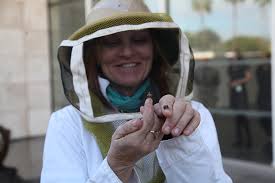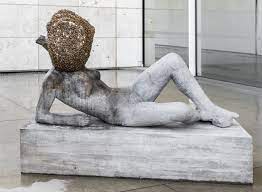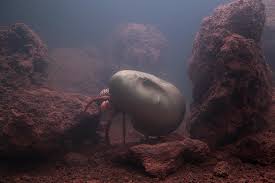Nature in the Arts
- Maya Chillingworth

- May 17, 2021
- 4 min read
Updated: May 23, 2021
The Royal Albert Hall filled their stage with 56,000 litres of water for their performance of 'Madam Butterfly'. How does water impact on an opera? What happens to the sound in the performance space? How sustainable is this set design? What health and safety impacts does this have? Is it necessary? There are many questions to consider when adding such an impactful element to a piece of work. But this has not stopped practitioners attempting to bring nature into their performances.
In 2019, Victoria Sin explored how language can reinforce identity and experience during 'If I Had Words To Tell You We Wouldn't Be Here Now' and used Chi-Wen Gallery's garden. Victoria Sin has a particular interest in exploring personal accounts of desire through alluring imagery and an other-worldly presence in her work.
The use of lighting is an interesting combination with this setting because it creates this detach from reality; the plants illuminated by deep colours give off an other-worldly feel that Victoria Sin uses to her advantage in communicating a narrative to the audience before the music or speech has begun. This is a simple technique, but highly effective in changing familiar plants to give them an alluring quality.
'The Rite of Spring' tells the tale of sacrifice to bring about a new Spring, often interpreted through the elements. Pina Bausch's interpretation of 'The Rite of Spring' in 1997 (a second staging of her 1975 performance) had performers, dressed in white, dance upon a thick layer of soil. Over the course of the performance, their pristine white dresses became caked in earth.
This was a highly intriguing way to utilise soil in telling a narrative, in which it displays the emotional story these characters embark on. However, there is more to be seen in bringing man and nature together...
Philosopher and artist, Pierre Huyghe creates ecosystems for audiences to explore. His exhibition at LACMA in 2014-2015 was composed of a series of nature meets man-made scenarios.
Bees burrowed in the head of a sculpture until honey dripped down its body. Huyghe's 'Human' involved his Ibizan Hound, with a pink leg, roaming free around the exhibition, able to leave or eat whenever it pleased. A glass tank contained a hermit crab, arrow crabs, a resin mask and basalt rock in 'Zoodram 5.' And 'Nympheas Transplant' displayed Monet's waterlilies from an underwater perspective, as opposed to the subtle blue one that we are familiar with. The work seems to attempt to develop ecosystems within the boundaries of human-made structures. In 2017, Huyghe unveiled 'After ALife Ahead,' where he ripped up a concrete floor ice rink in Germany, and filled it with a clay and sand environment for visitors to wonder through, surrounded by algae and bacteria, peacocks and bees that existed in the space. His more recent piece, titled 'UUmwelt' (2018), was another response to human activity and their surroundings. The imagery the onlooker sees uses brain activity to adjust its visuals rapidly. The AI monitors the activity of the onlooker as they try to fathom the image and sifts through exemplar images in order to create a representation of what the person might be imagining. Something I saw as an onlooker at UUmwelt
But as the image changes, so does the ideas that comes to the person's mind, which is why the image never stops adjusting and so does the person's thought process. It's a never ending cycle. However the pace at which the images change is impacted by the existence in the space, and not just the humans who are triggering sensors. 50,000 bluebottles existed in the space, feeding off the sugar compounds left for them, and their presence triggers the speed at which the images adjust. This is not simply human beings responding to an environment they are being put into. This is the environment responding to them.
When considering how this exhibition affected me emotionally, I can say it was both calming and distressing. Trapped in the enjoyable guessing game of being the onlooker, I could not help but want to tell the image that it was okay to stop. The reason I finish on this piece is that I fear we are unable to stop and psychologically that impacts on us greatly. I cannot say why Huyghe decided to give flies a say in the speed of the canvases, but I think that maybe nature can help us slow down because we are always connected to it.
I think its important to question the necessity of digging up nature and taking it inside. Whether you know the answer or not is not necessarily important, but it's worth keeping in mind when you consider the many factors that go into these additional elements. In fact, thinking out the box when it comes to the elements can create something truly incredible; nature can also be considered in relation to the man-made world and its relationship to our psychological health. I don't even think it requires a massive budget and a set filled with water; I think there are items surrounding us that we trust and love, which can be taken and warped by nature. Possibly a reckoning for human kind is not the end of the world, but rather the end of mankind, in which nature eventually takes control of the structures we have left behind. Would it not be incredible to display a world where our recognisable items are altered by nature, and see how beautiful or terrifying that is?
Sources
Tewksbury, D. (2014). Pierre Huyghe's Unpredictable Ecosystems at LACMA. Available at: https://www.kcet.org/shows/artbound/pierre-huyghes-unpredictable-ecosystems-at-lacma (Accessed 25/04/2019)
ZKM. (2016). Monet’s Water Lilies in the aquarium. Available at: https://zkm.de/en/blog/2016/09/monets-water-lilies-in-the-aquarium (Accessed 25/04/2019)
Los Angeles County Museum of Art. (2015). Pierre Huyghe. Available at: http://www.lacma.org/sites/default/files/PierreHuyghe_Brochure_LACMA.pdf
Camiolo, R. (2017). Pina Bausch - Extract from the Rite of Spring. Available at: https://www.youtube.com/watch?v=0VqaGkKQRCU (Accessed 19/04/2019)
VernissageTV. (2017). Pierre Huyghe: After ALife Ahead / Skulptur Projekte Münster 2017. Available at: https://www.youtube.com/watch?v=eWre6dlUAbo (Accessed 19/04/2019)
VictoriaSin. (2019). If I had the words to tell you we wouldn't be here now. Available at: http://victoriasin.co.uk/index.php/projects/if-i-had-the-words-to-tell-you-/ (Accessed 25/04/2019)
Royal Albert Hall. (2014). Trailer: Madam Butterfly at the Royal Albert Hall. Available at: https://www.youtube.com/watch?v=rVFu098IrSk (Accessed 19/04/2019)




















Comments